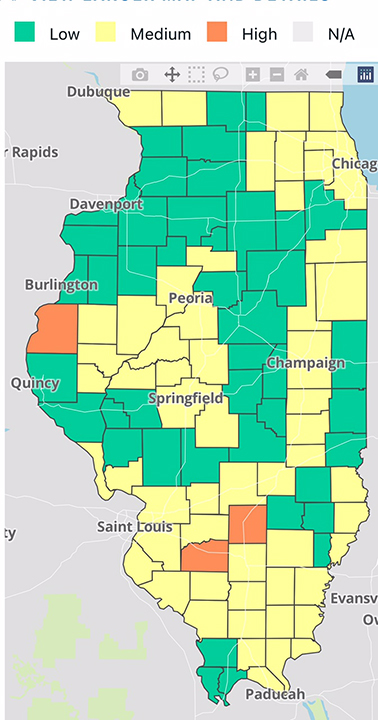CHICAGO – The Illinois Department of Public Health (IDPH) announced Friday that the CDC is reporting 28 counties in the state are at an elevated level for COVID-19, compared to 61 in the previous week. Of those, three Illinois counties are at a High Community Level, compared to five the previous week; and 25 counties are at Medium Level, compared to 56 the previous week. IDPH is reporting 10,967 new confirmed and probable cases of COVID-19 in Illinois in the week ending January 15, and 78 deaths.

The latest map shows Randolph County at a medium community level.
“I am encouraged to see COVID-19 community levels continuing to decrease across Illinois,” said IDPH Director Dr. Sameer Vohra. “Rates of the XBB ‘Kraken’ variant, spreading throughout the East Coast, are slowly increasing in the Midwest, and we continue to monitor this new variant closely. However, we are fortunate at this time to see no increase in hospitalizations. IDPH is continuing to focus our efforts on preserving hospital capacity and protecting those Illinois residents most at risk for severe disease from COVID-19 and other respiratory illnesses.”
Access to tests and treatments can be found at the following test to treat site or by contacting your provider for treatment options, within 5 days of feeling ill.
IDPH is helping Illinoisans prepare for the fall and winter surge of COVID-19 cases by offering 1 million free COVID-19 rapid antigen tests to Illinois residents in all zip codes outside the City of Chicago through a partnership with the Rockefeller Foundation’s public charity, RF Catalytic Capital and its Project ACT (Access COVID Tests) program.
Through Project ACT, IDPH is distributing up to one million at-home antigen tests to 200,000 Illinois households. You can request one package of five tests on a first-come-first-serve basis at the Project ACT website. The tests will be delivered to the home address.
Free or low cost COVID-19 testing locations are also available throughout the state, including in Chicago, and can be found on the IDPH website’s testing locator page.
The CDC authorized two new bivalent booster vaccines on September 1 that include an mRNA component of the original strain to provide an immune response that is broadly protective against COVID-19 and an added mRNA component in common between the omicron variant BA.4 and BA.5 lineages to provide better protection against COVID-19 caused by the omicron variant.
Initially, the Moderna COVID-19 Vaccine, Bivalent, was authorized for use as a single booster dose in individuals 18 years of age and older and the Pfizer-BioNTech COVID-19 Vaccine, Bivalent, was authorized for use as a single booster dose in individuals 12 years of age and older. On October 12, the CDC authorized the updated COVID-19 vaccines from Pfizer-BioNTech for children ages 5 through 11 years, and from Moderna for children and adolescents ages 6 through 17 years.
On December 9, the CDC expanded its authorization for bivalent boosters to include children aged 6 months to 5 years. Children ages 6 months through 5 years who previously completed a Moderna primary series can now receive a Moderna bivalent booster 2 months after their final primary series dose. Children ages 6 months through 4 years who are completing a Pfizer primary series will receive a Pfizer bivalent vaccine as their third primary dose.
The updated boosters are available at pharmacies, hospitals, and other healthcare providers. The best way to locate a vaccine provider near you is to visit www.vaccines.gov and search for bivalent booster availability.
Currently, IDPH is reporting a total of 4,008,844 cases, including 36,000 deaths, in 102 counties in Illinois since the beginning of the pandemic.
As of last night, 1,220 individuals in Illinois were reported to be in the hospital with COVID-19. Of those, 151 patients were in the ICU and 57 patients with COVID-19 were on ventilators. The preliminary seven-day statewide case rate is 86 COVID-19 cases per 100,000 Illinoisans.
The CDC recommends the following measures for people in areas that are rated at High Community Level for COVID-19 transmission:
- Wear a well-fitting mask indoors in public, regardless of vaccination status (including in K-12 schools and other indoor community settings)
- If you are immunocompromised or high risk for severe disease
o Wear a mask or respirator that provides you with greater protection
o Consider avoiding non-essential indoor activities in public where you could be exposed
o Talk to your healthcare provider about whether you need to take other precautions
o Have a plan for rapid testing if needed (e.g., having home tests or access to testing)
o IF YOU TEST POSITIVE: Talk to your healthcare provider about whether you are a candidate for treatments like oral antivirals, and monoclonal antibodies
- If you have household or social contact with someone at high risk for severe disease
o consider self-testing to detect infection before contact
o consider wearing a mask when indoors with them
- Stay up to date with COVID-19 vaccines and boosters
- Maintain improved ventilation throughout indoor spaces when possible
- Follow CDC recommendations for isolation and quarantine, including getting tested if you are exposed to COVID-19 or have symptoms of COVID-19
